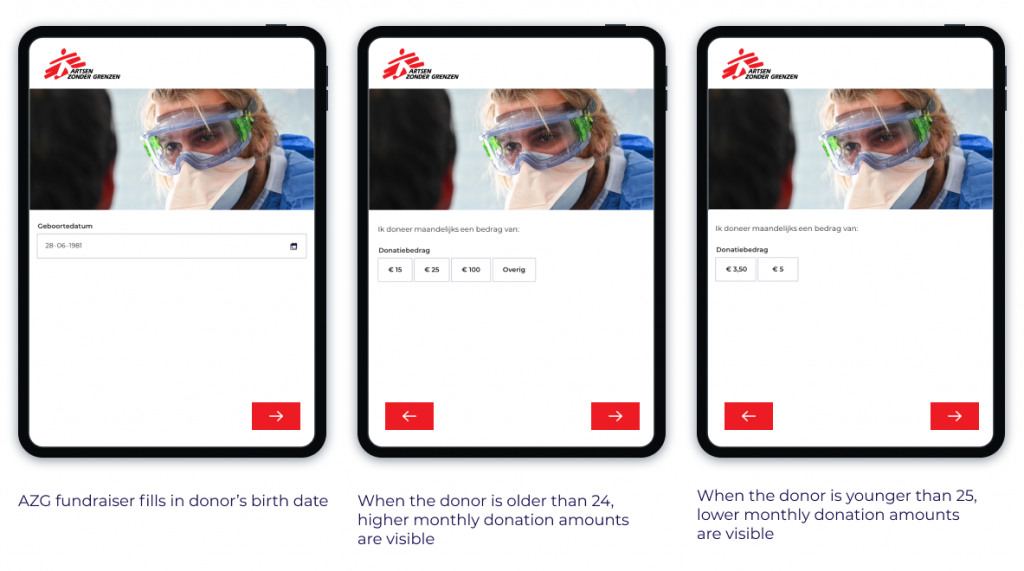
Olya Kudinenko: If you’re going through hell, keep going
April 5, 2023
Driving standards ever higher in F2F fundraising
May 17, 2023With a focus on face-to-face (F2F) fundraising, in this article we find out from experts in the field how technology is helping Europe’s nonprofits boost engagement and signups, motivate fundraisers, and bring in more vital income.
After the difficult pandemic years, where face-to-face fundraising ceased literally overnight across Europe, use of the channel has since rebounded. In fact, EFA’s latest Nonprofit Pulse report reveals that 43% of nonprofits across Europe were using F2F in 2022, up from just 16% the previous year.
And no wonder: F2F fundraising – whether that’s door-to-door, on private sites like shopping centres, or on the street – is a key recruitment channel for most charities that use it.
Getting the most from it requires fundraisers who can tell a good story, an easy and secure signup process, and a well-integrated supporter journey for newly recruited donors. And this is where digitisation and technology are playing an increasingly important role, enabling fundraisers to more meaningfully engage with the people they meet and provide a great experience. It’s boosting supporter numbers and income for nonprofits, while reducing the attrition risk.
In Germany, where Talk2Move has been helping nonprofits including WWF and SOS Children’s Villages with their F2F street campaigns since 2005, managing director Robert Hatwagner shares some of the developments he’s seen over the years:
“Technology has really helped to professionalise F2F. First, we moved from filling in forms on paper to inputting those details on a tablet, then to using videos to better engage people with a cause. Now technology also enables us to provide fundraisers with suggestions on how to respond to individual members of the public, based on details such as their age, and including what size of donation it’s appropriate to ask for.”
Telling the story
Above all, what makes F2F so impactful is the in-person contact it provides with someone who is passionate and knowledgeable about that cause. The F2F fundraiser’s first job is to engage, and that’s where great communication and storytelling skills are critical.
As Sezayi Arslan, marketing director at Dutch F2F solutions provider Briggs + Walker says:
“F2F is not just about getting money. It’s about helping someone connect with the cause, so it’s really important that in this first touchpoint the fundraiser tells the right story.”

Elsbeth de Ridder, Save the Children Switzerland
It’s also where having the right tools can make all the difference. Pre-pandemic, as noted by Hatwagner, some charities and F2F agencies were already equipping their fundraisers with tablets, with these and other technologies becoming more commonplace as F2F opened up post-lockdown. Essential for fast and accurate data capture, tablets also help to boost engagement by enabling fundraisers to use story decks, pictures, and short videos to explain the charity’s work and thank new signups.
Save the Children International conducts face to face all year round in the majority of its markets, recruiting most of its individual giving donors – between 65% and 100% depending on the location – this way.
Elsbeth de Ridder, previously global F2F specialist, Save the Children International and now head of individual giving at Save the Children Switzerland, says:
“In the majority of our markets, all our fundraisers work with iPads, on which they have a pitch deck and, in some markets, a short video on the work we’re able to do thanks to donations – shown to people who have just signed up. In a video used in Switzerland a mother talks about her son who was really sick and received our help, and as a result is now able to give her a cuddle again. We call it the Cuddles Video. It’s short – around 20 seconds – so keeps people’s attention but it really makes new donors feel they made the right choice and that supporting us is a good thing to do.”
- Save the Children International Cuddles video
Simple & secure signups
Covid also hastened uptake of other useful tools for nonprofits, including SMS and QR codes that facilitate a contact-free signup process.
Elsbeth de Ridder adds:
“After Covid there was a big push for contact-free signups. We couldn’t share iPads, pens or paper so we had to move quickly to new solutions.”
Letting people fill out their details securely as well as safely, this technology also helps build trust among the new supporters, whilst speeding up the signup process.
Jeroen Meijer, Briggs + Walker director of sales & business development says:
“People can find it quite awkward from a security perspective to share their personal and bank details on the street. We offer them a QR code to scan so they can fill them out on their own phone. This also enables fundraisers to be sure their details are correct, making it easy for them to focus on having a really good conversation.”
Providing payment options
F2F fundraising is also developing in another way, with nonprofits starting to provide options for giving, rather than just the one route of a predetermined regular gift payable via direct debit.
These include one-off donations via GooglePay and ApplePay, as well as subscription-style and continuous card payments. As well as providing people with more choice, a key benefit of these methods for the charity is the immediate payment at the time of sign up.
In the UK, more and more testing is taking place of alternative and emerging payment methods. Direct dialogue agency Gather Campaigns for example is trialling continuous card payment with a variety of organisations with diverse causes, from UK domestic to overseas development charities.

Dominic Will, Gather Campaigns
Dominic Will, Gather Campaigns managing director UK & Europe, says:
“Nonprofits need to maximise every opportunity to raise funds, and giving people payment choices in F2F fundraising is better for both parties. Continuous card payment, for example, offers people a way to give that’s much faster and easier to set up than a traditional direct debit. For the donor it’s a simple card payment, without the lengthy forms and set up process of a direct debit mandate – instantly visible in their bank account in the same way as their other day to day payments.
“For the charity it captures the first donation immediately, so that payment is in the bank without having to wait for a month or six weeks for a direct debit to be set up and make first payment. This crucial time saving means the organisation can effectively gain an extra monthly donation, very quickly communicate their thanks and start building a supporter relationship while the conversation that inspired their giving is still fresh and front of mind.”
In addition, some nonprofits are also offering options for how to support in their F2F conversations: asking for a donation but also perhaps offering an opportunity to volunteer, play a lottery, or of simply being kept updated with their news. For every person that signs up, a fundraiser talks to many more – engaging new and diverse audiences through the power of a good conversation, educating them on that charity and its work, and building awareness and engagement. All of this has the potential to start a longer-term relationship on the supporter’s terms, whilst helping nonprofits to widen their reach.
Improving retention
Of course, everything from how the fundraiser engages with a member of the public, to the story they tell, and the ease of the signup process, plays a role in whether that person becomes a long-term supporter. But a seamless link between a new donor signing up and the next step in their supporter journey is another essential ingredient in lowering attrition for F2F fundraising.
Technology is helping here too, with the speed of payment some options provide enabling nonprofits to follow up and thank a donor the day they sign up. It means they are also able to install them on an engaging supporter journey while they’re still inspired and excited by their conversation with the fundraiser. Doing exactly this, Gather Campaigns say they are seeing a reduction in early attrition rates.
Retention is also a key focus for MSF Netherlands. It has two inhouse F2F offices and works with four agencies. While the nonprofit has been using F2F for many years, its inhouse operation started in 2018 as one of the first in the country. Activity is a mix of D2D and street fundraising, with most of its donors – around 90% – coming through this channel.

Linde de Wit, MSF Netherlands
Working with Briggs+Walker, the nonprofit introduced a low entry donor proposition to bring in younger donors put off by the usual amount asked for. Based on their date of birth, the software used by the fundraiser presents different options. While the margin per new donor may be lower, it has found that the uptick in conversion outweighs this, while a carefully planned onboarding process is helping with retention. [More here, and below]
Linde de Wit, fundraising officer at MSF Netherlands explains:
“For now we still only ask for monthly donations with F2F but have developed a lower-entry proposition to engage younger donors who we had noticed were put off by our minimum donation limit. New donors receive an immediate confirmation email, and a welcome call to make sure everything is clear and their data is correct. To help reduce churn, we have an onboarding journey especially for F2F-recruited donors that lasts for a year. The quality of fundraiser performance and the signup process is really important to us and we have dashboards through which we can track how our fundraisers in the field are doing, so we can provide support.”

Briggs+Walker smart donation forms for MSF Netherlands
Similarly, Shelter UK is also very focused on what happens not just during, but after signup too. It has had its own inhouse F2F teams since 2009, now working in every major city in the UK. It currently has a mix of street, D2D, private site and lottery fundraising. This is split between inhouse and agency, and brings in around 20,000 new donors each year.
Jon Lyons, its head of F2F fundraising (direct dialogue) says:
“Retention is everything to us, which is why our supporter experience is at the forefront of our work, once you sign up with us you receive your welcome email and links to our campaigns, we will then keep in contact regularly with our donors to update them and create the best tailored donor journey we can. When we sign you up, we use a secure online F2F platform to do so, it has capabilities to sign you up to campaigns and interact with the donor in a way that gets the best possible response, including showing videos and images.”
Tracking results
Tracking performance of course is critical for ensuring any and all techniques and activity are working as they should be.
Live team tracking is providing nonprofits with real-time insights into how fundraisers, campaigns, and the areas they’re working in are performing, enabling them to respond immediately and speeding up that vital feedback loop. This capability is playing a critical role in continuing to drive up standards for individual organisations, and for the sector as a whole.

Jeroen Meijer, Briggs+Walker
Meijer says:
“Through seeing who performs well, or not so well, and why, through gaining valuable insights into campaign and conversions, we can ask ourselves: how we can learn from that? How we can improve? Can we tell the story in a better way? And how can we make sure we keep the public’s trust?”
It’s also key to inspiring and motivating the fundraisers themselves. Max Jakob, managing director and co-owner at F2F fundraising software provider Formunauts in Austria, comments:
“Only happy and well-trained fundraisers will recruit happy donors who can then enable organisations to do their important work. Today fundraisers are being motivated by digital achievements, which are unlocked through their performance and they can access training materials and quizzes directly on their tablet to ensure they are always up to date and well-trained.”
He highlights the use of digital donor feedback as a key development in how technology is helping to improve fundraiser motivation and performance:

Max Jakob, Formunauts
“Digital donor feedback is a great example of how a simple and, within our service, a free piece of technology can improve how we engage with donors and motivate fundraisers alike, ensuring better retention for both. It’s not a secret that as a fundraiser we hear a lot of “NOs” every day. However, the people that give us the YESes are highly committed donors and very thankful for the conversation that made them become a donor. Showing this feedback to the fundraiser on their dashboards in real-time, as well as giving them digital badges for positive feedback, does motivate immensely.”
The power of a conversation
In a nutshell then, success in F2F fundraising rides on a combination of equally important factors – supported increasingly by technology.
Will concludes:
“At its heart, what hasn’t changed in the course of human history is that the power of a strong conversation is still what will essentially yield results. But that can be supported hugely by technology, both in terms of making sure people have access to information to support that conversation, and the freedom to offer choice in how someone wants to support. It’s then about tracking your results and understanding how you’re doing in real time and being able to act swiftly and meaningfully in your conversion to the supporter journey. Today, technology is playing a huge part both in terms of how you manage and train your fundraisers, and how you offer choice to supporters.”







